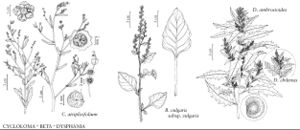Beta
Sp. Pl. 1: 222. 1753.
Gen. Pl. ed. 5, 103. 1754.
| Taxon | Illustrator ⠉ | |
|---|---|---|
 | Cycloloma atriplicifolium Beta vulgaris subsp. vulgaris Dysphania chilensis | Bee F. Gunn Yevonn Wilson-Ramsey Yevonn Wilson-Ramsey |
Herbs, annual, biennial, or perennial, often with fleshy, thickened roots, glabrous throughout. Stems erect or procumbent, not jointed, not armed, not fleshy. Leaves alternate, petiolate or sessile; blade ovate-cordate to rhombic-cuneate, margins ± entire, apex obtuse. Inflorescences spikelike cymes or glomerules, ebracteate at least in distal 1/2. Flowers bisexual, bracteate; perianth segments 3–5, distinct, sometimes petaloid, rounded or keeled abaxially, wings and spines absent; stamens 5; ovary semi-inferior; stigmas usually 2–3 (–5), connate basally. Fruiting structures achenes, connate with receptacle, often enclosed by swollen perianth. Seeds horizontal, orbicular or reniform; seed-coat dark-brown, smooth; embryo ± annular, perisperm copious. x = 9.
Distribution
Introduced; Eurasia
Discussion
Species ca. 6 (1 in the flora).
Beta is widely distributed and is known especially for the economically important Beta vulgaris subsp. vulgaris, the commonly cultivated beet. The forms of the beets introduced in North America and established in the wild occupy both inland and maritime habitats.
The taxonomy of the genus is complicated by a long history of cultivation in which selective breeding has caused a bewildering array of diverse morphologies. In looking at the differences between the two forms of Beta that occasionally become established in waste places in North America, it is tempting to segregate the clearly distinct forms as different species. However, a number of researchers documenting the variation within the complex (B. V. Ford-Lloyd and J. T. Williams 1975; H. Van Kijk and B. Desplanque 1999) agree that the range of variation stretches along a continuum between the two extreme types defined by the maritima and vulgaris groups. The morphological lineage assigned here to subsp. maritima is usually considered ancestral to the cultivated forms of beet included within subsp. vulgaris.